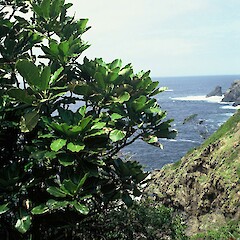Meryta sinclairii
Common name
pukanui, puka
Synonyms
Botryodendrum sinclairii Hook.f.
Family
Araliaceae
Flora category
Vascular – Native
Endemic taxon
Yes
Endemic genus
No
Endemic family
No
Structural class
Trees & Shrubs - Dicotyledons
NVS code
The National Vegetation Survey (NVS) Databank is a physical archive and electronic databank containing records of over 94,000 vegetation survey plots - including data from over 19,000 permanent plots. NVS maintains a standard set of species code abbreviations that correspond to standard scientific plant names from the Ngä Tipu o Aotearoa - New Zealand Plants database.
MERSIN
Chromosome number
2n = 48
Current conservation status
The conservation status of all known New Zealand vascular plant taxa at the rank of species and below were reassessed in 2017 using the New Zealand Threat Classification System (NZTCS) – more information about this can be found on the NZTCS website. This report includes a statistical summary and brief notes on changes since 2012 and replaces all previous NZTCS lists for vascular plants.
Please note, threat classifications are often suggested by authors when publications fall between NZTCS assessment periods – an interim threat classification status has not been assessed by the NZTCS panel.
- Conservation status of New Zealand indigenous vascular plants, 2017 . 2018. Peter J. de Lange, Jeremy R. Rolfe, John W. Barkla, Shannel P. Courtney, Paul D. Champion, Leon R. Perrie, Sarah M. Beadel, Kerry A. Ford, Ilse Breitwieser, Ines Schönberger, Rowan Hindmarsh-Walls, Peter B. Heenan and Kate Ladley. Department of Conservation. Source: NZTCS and licensed by DOC for reuse under the Creative Commons Attribution 4.0 International licence.
2017 | At Risk – Naturally Uncommon | Qualifiers: CD, IE
Previous conservation statuses
2012 | At Risk – Naturally Uncommon | Qualifiers: CD, IE
2009 | At Risk – Naturally Uncommon
2004 | Range Restricted
Brief description
Small tree bearing very large glossy wavy leaves inhabiting the three Kings Islands (but common in cultivation and introduced to the Hen and Chickens Islands). Twigs fleshy. Leaves up to 50cm long, on stalks to 35cm long, tough. Fruit in clusters at tip of branches under the leaves, purple.
Distribution
Endemic. Three Kings Islands. It is probably planted on the Chickens near Whangarei
Habitat
Coastal forest, grassland and scrub. With the exception of the taller kanuka (Kunzea aff. ericoides (f)) dominated forest of Great island, Meryta is the dominant tree species on the Three Kings Islands.
Detailed description
Tree up to c.8 m tall, with trunk up to c.50 diameter; branches brittle. Leaves crowded at apices of branchlets, simple, on petioles up to c.350 mm long; lamina about oblong, semicordate at base, coriaceous, glossy, up to c.500 ~ 200 mm; margins very shallowly broadly lobulate, slightly undulate. Panicles terminal, erect, up to 50 mm long, about oblong in outline, branches jointed in bracted clusters; calyx obsolete, petals 4-5, greenish; stamens 4, bracted, crowded; calyx obsolete, staminodes present, style-branches 4-5. Fruit 10 mm or more long, succulent, black, 4-5-loculed; seeds solitary in each locule.
Similar taxa
None
Flowering
August - April
Flower colours
Green
Fruiting
Throughout the Year
Propagation technique
An extremely attractive and popular tree widely cultivated in northern New Zealand. Easily grown from fresh seed which often germinates beneath the parent tree. However, prone to phytophora and verticillium wilt for which there is no available treatment. Best grown in a coastal situation, in free draining soil.
Threats
A Naturally Uncommon, range-restricted endemic. It is abundant in the wild on all the main islands and a few of the larger islets of the Three Kings group. However, this situation could easily change if soil borne fungal pathogens current absent from the islands are introduced - this is a constant threat because marijuana growers are increasingly using remote offshore islands to grow their crops, and their crops carry these diseases. Further, should rodents invade the islands then the Meryta along with many other plants and animals unique to the islands will be under certain risk. The future of these islands is ensured only by regular visits checking for rodents and weeds, undertaken by the New Zealand Department of Conservation.
Etymology
meryta: Rolled up
sinclairii: After Sinclair (c. 1796–1861). Colonial Secretary and naturalist.
Attribution
Description from Allan (1961)
References and further reading
Allan, H.H. 1961: Flora of New Zealand. Vol. I. Government Printer, Wellington.





